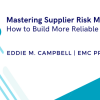Supply Chain Cyber Risk Management: Threats to Consider
Automation has become quite the norm across all industries. However, modern automation places a premium on interconnectedness. So it's no surprise that cyber risks are on the rise. It also means there's a greater probability of danger for every party involved.
Even with the latest and greatest security infrastructure, it's advisable not to rest on your laurels because your suppliers may not have as comprehensive protection in place as you do. For this reason, companies need to pay attention to potential supply chain cybersecurity risks to protect their sensitive information.
According to Security Magazine, 51 percent of companies became exposed to cyberattacks through third-party vulnerabilities. Cyber attackers are always on the lookout for opportunities to compromise organizational operations, making it urgent to patch security holes as soon as possible.
The Major Threats to the Digital Supply Chain
What threats must companies be aware of in a modern interconnected world? Hyperconnectivity keeps driving businesses to implement solutions that manage compliance, risk and governance, and they guarantee to deliver effective cybersecurity across the supply chain.
With cyber risks such as malware attacks and data breaches on the rise, the supply chain is a principal aspect of these attacks. Maintaining poor security practices enables cybercriminals to gain critical access to larger companies. Up to 80% of businesses suffered a data breach due to security vulnerabilities in their supply chains.
Here are the top cyber risks to consider in the modern supply chain.
Humans
People are more likely to ignore or disregard safe procedures concerning the supply chain. Sometimes it's unintentional or they fail to perform necessary checks and balances. Other times, they're just plain negligent or without the requisite knowledge or awareness.
An unhappy employee may choose to engage in malicious behavior that can harm the business’s reputation. Social engineering attacks leverage psychological weaknesses to worm their way into the company using elements such as anxiety, curiosity and trust.
Such craftiness by cyber thieves enables them to access email systems, understand policies and procedures, and impersonate supply chain vendors. One significant outcome of this is that companies can lose large sums of money. According to the SEC's Business Email Compromise document, companies are at greater risk of attack in the supply chain.
Critical Data
Successful supply chain attacks make sensitive data available to criminals. These reams of data often belong to supply chain partners of business organizations and governments. For instance, the recent COVID-19 vaccine supply chain attacks aimed to steal vaccine information, while the Airbus attack targeted technical aircraft documents.
More than money, threat actors may prefer to exploit trade secrets and intellectual property. It is crucial for IT teams to work with the organization to identify and classify supply chain assets and build appropriate protection.
Weak Own and Third-Party Links
Manufacturing facilities often use third-party services to make some of their products. Similarly, digital businesses use third-party tools to build their products and services. The services may include advertising, analytics, chatbots, payments, social media integrations and known as “Shadow Code.”
Such third-party services introduce risks to businesses, presenting challenges in protecting critical data and guaranteeing data privacy. The websites with the highest traffic usually have unsupervised third-party JavaScript integrations and lack adequate security controls against credit card skimming, cross-site scripting, form jacking and Magecart.
The coronavirus has caused global suppliers to suppliers to adopt cloud computing and remote working for business continuity. It inevitably introduces unwanted security risks.
Inadequate Vendor Risk Management
For businesses to effectively secure their supply chains or minimize risks, they need a thorough grasp of vendors and third-party risks.
Businesses need a formal process of due diligence when selecting vendors. Besides, it’s advisable to have strict vendor oversight and monitoring. Also, use risk parameters such as criticality, financial, legal, operational, privacy and reputation to rank vendors. Each vendor's risk profile must remain under continuous scrutiny to ensure prompt detection of changes.
An organization’s risk management processes need to evolve in tandem with risks. Without a flexible risk management process, it’ll be challenging to effectively manage supply chain cyber risk.
Lack of a GRC Platform
For effective risk management, the security system is always active and consists of several complementary components. To achieve a streamlined process to take care of risks, it is necessary to have a governance, risk and compliance (GRC) platform.
A GRC platform serves as a single outpost for managing and monitoring risks in the supply chain. Therefore, imagine using Microsoft Outlook to store emails of people sending in questionnaires in an Excel spreadsheet. It becomes less convenient over time. Ticketing systems may help mitigate the tedious process, but a ticket gets closed as soon as one completes an activity.
Risk management is a continuous process. Besides an active risk management framework, there's the issue of executing an effective program. Without a GRC platform, an organization's security program could end in shambles.
Improving Your Cybersecurity
Security is a broad discipline. In the supply chain, it's necessary to attack several fronts. It's essential to understand and monitor all supply chain assets and associated risks.
It's also critical to know and document who's in the system and when they're live on it. Employees need to appreciate the sensitivity of data fully and follow security best practices to fulfill all regulations.
With an adequate incident response plan for third parties, it's easier to deal with data breaches or malware attacks. Begin with a risk register of processes, resources and technologies across the supply chain. Ensure you have key stakeholders aware of what's going on and implement a flexible program and platform to monitor and adapt to evolving risk.
In the increasingly interconnected enterprise, solutions that streamline GRC are better suited to deliver effective cybersecurity across the supply chain.









